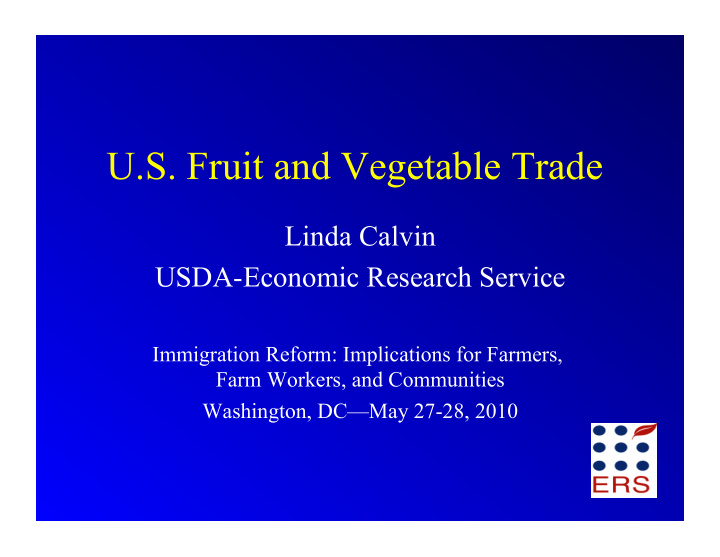



U.S. Fruit and Vegetable Trade Linda Calvin USDA-Economic Research Service Immigration Reform: Implications for Farmers, Farm Workers, and Communities Washington, DC—May 27-28, 2010
U.S. imports, 1990 and 2009 1,000 mts 6000 5000 15% 4000 20% ROW 3000 Canada 65% Mexico 2000 38% 1000 0 1990 2009 1990 2009 Vegetables Fruit (fresh and processed) (fresh and processed) Source: U.S. Department of Commerce
U.S. production and trade statistics Source: ERS, Fruit and Tree Nuts Yearbook and Vegetables and Melons Yearbook
Some Factors Affecting Trade • Climate • Technology • Biology • Consumer demands for variety and year- round supply • Business risk • Labor costs • Declining tariffs
Winter field tomato production areas
Changes in technology U.S.-Canadian tomato trade 1,000 mts 160 140 120 100 U.S. exports to Canada 80 60 U.S. imports from 40 Canada 20 0 Source: U.S. Department of Commerce.
Western table grape production areas
U.S. shipments of fresh grapes, 2009 100,000 lbs 4,000 3,500 3,000 2,500 Others 2,000 Chile Mexico 1,500 United States 1,000 500 0 Jan Mar May Jul Sep Nov Source: USDA, Agricultural Marketing Service.
U.S.- Mexican grape trade 1,000 mts 180 160 140 120 100 U.S. exports to Mexico 80 U.S. imports from 60 Mexico 40 20 0 Source: U.S. Department of Commerce
Lettuce production for the U.S. market
Green onion production for the U.S. market
U.S. shipments of green onions 100,000 lbs 3,500 3,000 Mexico 2,500 2,000 United States 1,500 1,000 500 0 1980 1990 2000 Source: USDA, AMS
U.S. supply of fresh asparagus, 1900-2009 450 400 350 Peru 300 250 200 Mexico 150 100 United States 50 0 1990 1992 1994 1996 1998 2000 2002 2004 2006 2008 Source: U.S. Department of Commerce
Asparagus shipments, 1990 and 2009 700 700 Mexico 600 600 500 500 400 400 Peru United 300 300 States 200 200 100 100 0 0 Jan Jul Jan Jul Source: USDA, Agricultural Marketing Service
Summary • Not all increases in imports imply that U.S. production is uncompetitive due to labor • Other factors besides labor – Tomatoes (weather, technology) – Grapes (biology, consumer demands) – Lettuce (business risk) – Green onions (labor) – Asparagus (labor and declining tariffs)
www.ers.usda.gov
U.S. exports, 1990 and 2009 1,000 mts 6000 5000 4000 ROW 3000 Canada 2000 Mexico 1000 0 1990 2009 1990 2009 Vegetables Fruit (fresh and processed) (fresh and processed)
U.S.-Mexican fresh tomato trade 1200 1000 800 U.S. exports to Mexico 600 U.S. imports from 400 Mexico 200 0 Source: U.S. Department of Commerce
U.S. lettuce imports from Mexico and Canada, 2000-2009 1,000 mts 120 100 80 60 Canada Mexico 40 20 0 2000 2002 2004 2006 2008 Source: U.S. Department of Commerce
U.S. frozen broccoli supply, 1978-2009 Million lbs 900 800 700 600 500 Mexico 400 300 Others 200 United States 100 0 1980 1990 2000 Source: U.S. Department of Commerce, ERS
Broccoli imports, 2007 Frozen Import share of consumption 92 Import share: Mexico 73 Guatemala 13 Ecuador 9 China 5 Canada * • Is less than 1%. • Source: U.S. Department of Commerce
Broccoli imports, 2009 Fresh Frozen Import share of consumption 12 92 Import share: Mexico 97 73 Guatemala * 13 Ecuador * 9 China * 5 Canada 2 * • Is less than 1%. • Source: U.S. Department of Commerce.
Decline of U.S. asparagus industry Million lbs farm weight 250 Freezing 200 Canning 150 100 Fresh 50 0 1990-02 average 2005-07 average Source: ERS, Vegetables and Melons Yearbook
Recommend
More recommend